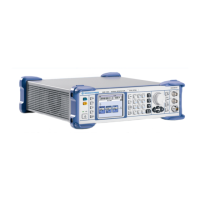Remote Control Basics
R&S
®
SMB100A
229Operating Manual 1407.0806.32 ─ 13
# The hash symbol introduces binary, octal, hexadecimal and block data.
●
Binary: #B10110
●
Octal: #O7612
●
Hexa: #HF3A7
●
Block: #21312
A "white space" (ASCII-Code 0 to 9, 11 to 32 decimal, e.g. blank) separates the header from the
parameters.
6.3.5 Structure of a command line
A command line may consist of one or several commands. It is terminated by one of the
following:
●
a <New Line>
●
a <New Line> with EOI
●
an EOI together with the last data byte
Several commands in a command line must be separated by a semicolon ";". If the next
command belongs to a different command system, the semicolon is followed by a colon.
Example:
MMEM:COPY "Test1","MeasurementXY";:HCOP:ITEM ALL
This command line contains two commands. The first command belongs to the MMEM
system, the second command belongs to the HCOP system.
If the successive commands belong to the same system, having one or several levels in
common, the command line can be abbreviated. To this end, the second command after
the semicolon starts with the level that lies below the common levels. The colon following
the semicolon must be omitted in this case.
Example:
HCOP:ITEM ALL;:HCOP:IMM
This command line contains two commands. Both commands are part of the HCOP com-
mand system, i.e. they have one level in common.
When abbreviating the command line, the second command begins with the level below
HCOP. The colon after the semicolon is omitted. The abbreviated form of the command
line reads as follows:
HCOP:ITEM ALL;IMM
A new command line always begins with the complete path.
Example:
HCOP:ITEM ALL
HCOP:IMM
SCPI Command Structure

